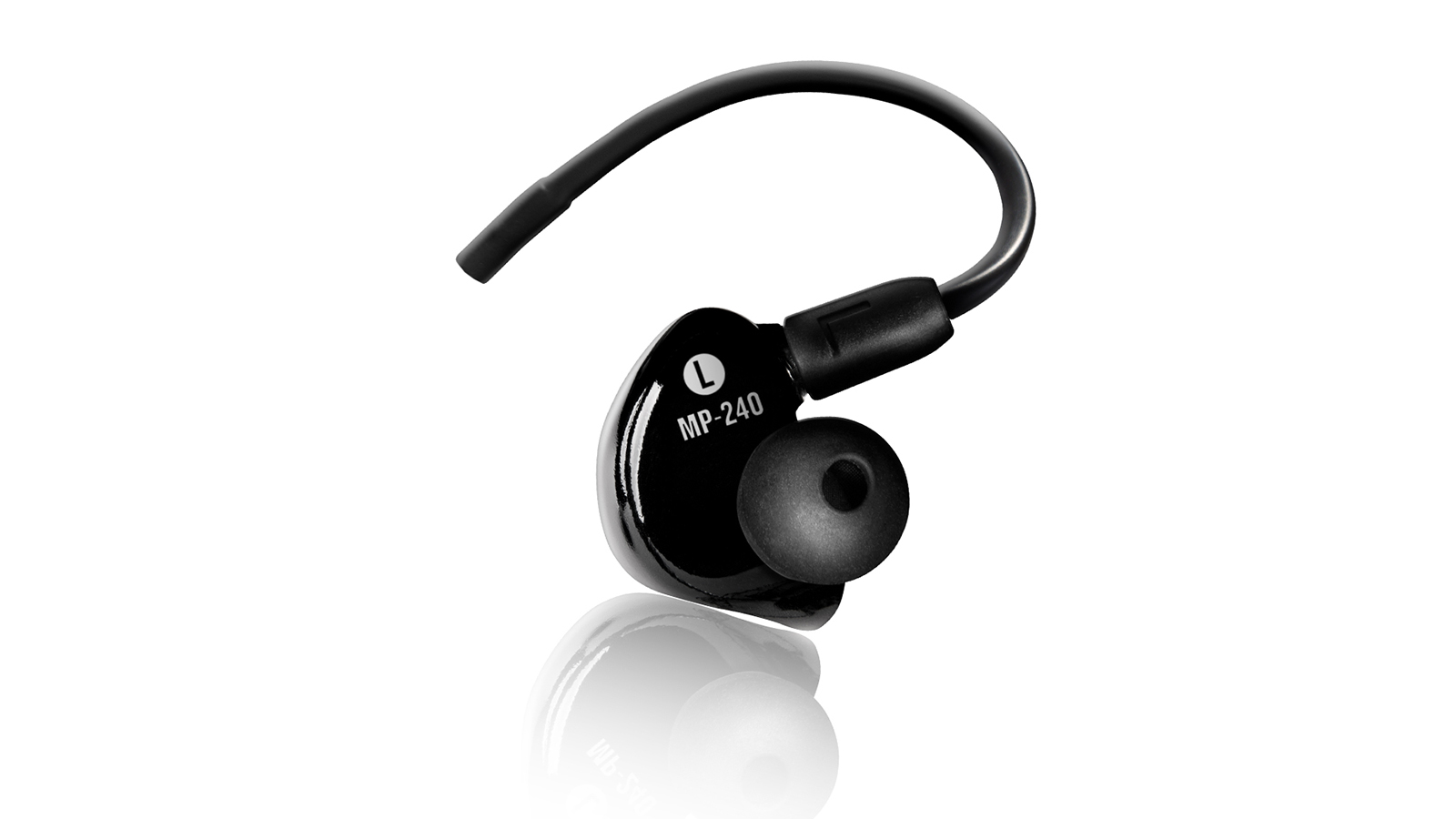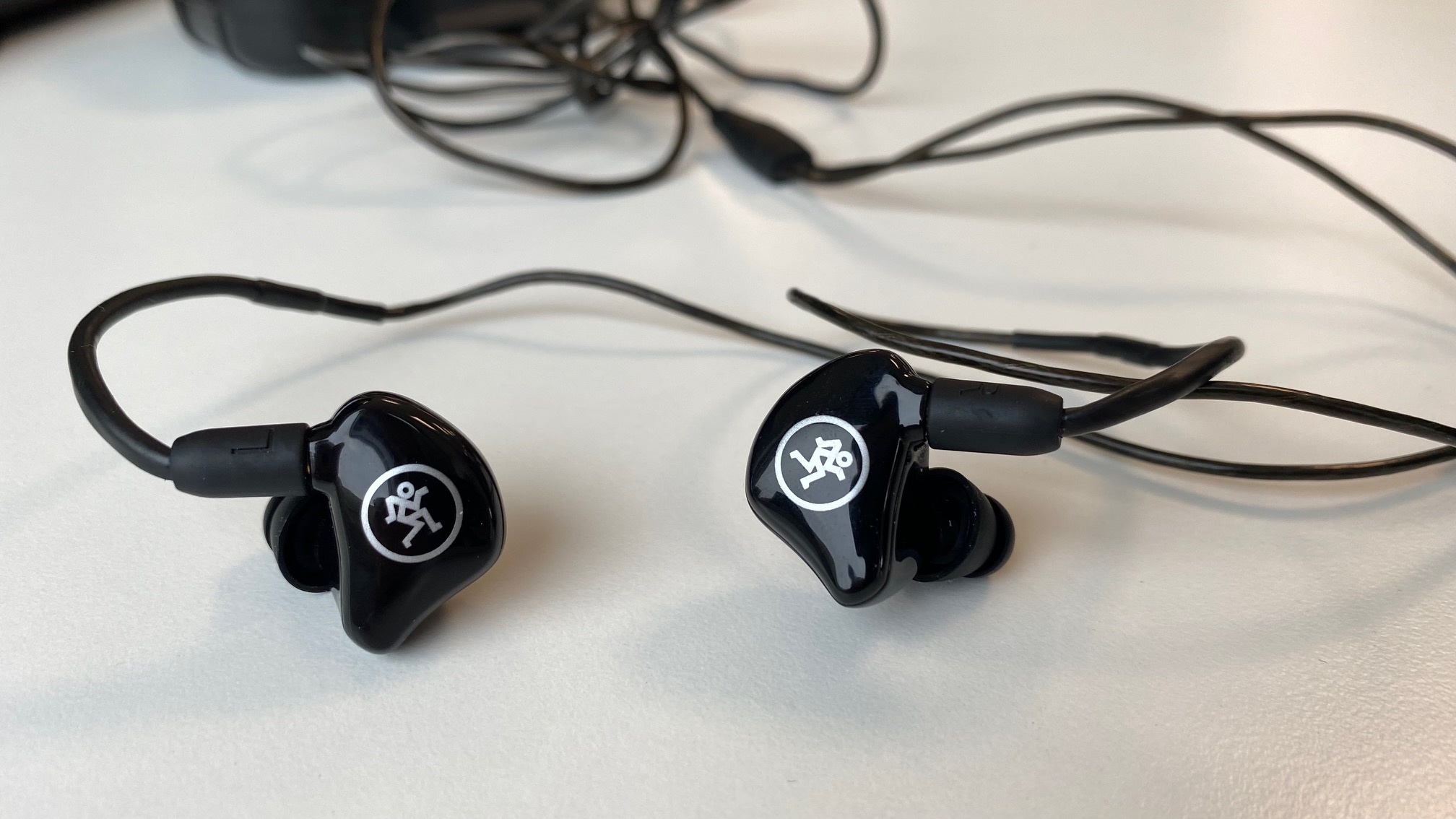MusicRadar Verdict
Revealing outstanding detail across the board, these top-performing pro IEM's will soon become your best buds.
Pros
- +
Brilliant sound
- +
Bluetooth capability with BTA
- +
9 pairs of interchangeable tips
Cons
- -
Standard cord a bit short
- -
BTA not truly ‘wireless’
MusicRadar's got your back
What is it?
Primarily designed for on-stage use by performing musicians, Mackie’s MP range of professional in-ear monitors (IEMs) comprises six models, each featuring a different driver design configuration. The entry level MP-120’s have a single dynamic driver, the MP-220’s feature dual dynamic drivers, while the MP-240’s, the focus of this review, are described as a dual hybrid driver design. This means that audio reproduction is divided between a dynamic driver for the low-end and a separate, ultra-efficient Knowles balanced armature driver for the mids and highs.
The model range continues upwards with triple and even quadruple driver designs, but on test here we had the MP-240 BTA, which ships with a bundled Bluetooth adapter for connecting wirelessly to Bluetooth-enabled devices such as mobile phones, tablets and computers.
In the box, aside from the IEM’s themselves and their standard 1.5m cable that terminates in a stereo 3.5mm minijack, you get a 6.3mm stereo adapter, a selection of switchable foam or silicone ear tips in three different sizes, the BTA Bluetooth adapter and its USB charging cable, plus a cute little hard plastic flight case to transport everything in.
The IEM’s are constructed from tough, shiny black plastic, with the Mackie logo displayed prominently on the outward-facing surface and model designation and L/R label displayed on the inner surface when worn, all of which helps to orient the buds when inserting them into your ears.
- After a bargain? These are the best budget in-ear monitors
- And the best budget studio headphones
Finding the size and style of tips that work best for your individual ear shape takes a bit of trial and error, but you do get plenty of options and it wasn’t too long before we found a comfortable long-term solution in the shape of the medium-sized, dual-flange silicone tips. Changing the tips proved fairly awkward though, requiring a lot of effort and gritting of teeth (and a good stretch with the pointy end of a pencil) to get the hole in the tip over the flange of the bud, so it’s not something we’d care to repeat too often.
If you’re more used to wearing conventional studio headphones, these anatomically-moulded monitors may take a bit of getting used to, not least with initially fitting them. Due to their precisely moulded shape, they only fit one way, so to begin with a fair amount of experimental rotation is necessary to get each bud in the correct orientation, after which they fit deeply and snugly into the ear canal, the outer surface of the unit sitting flush with the outside of your ear.
Even before you listen to anything, the excellent isolation from external noise - claimed to be a reduction of up to 40dB - becomes immediately clear, the internal noises of your head and neck suddenly glaringly apparent.
Want all the hottest music and gear news, reviews, deals, features and more, direct to your inbox? Sign up here.
Initially relatively comfortable, we found that an hour of constant wearing was about our limit before a minor degree of discomfort became apparent, although this is something that may improve over time with extended use.
Performance and verdict
To sum up the sound of the MP-240’s, we’d use one word - detailed. In our first test scenario, where Bluetooth connectivity wasn’t an option - plugged into the brain of a Roland electronic drum set - the supplied 1.5m cable connecting the buds to the mini-jack plug proved to be a little short. One extension cable later however, the MP240’s sounded impressively full, rich and loud - the impedance is only 32Ω, making these the first pair of monitors we’d used with the kit where we had to turn the drum module’s output volume down to a comfortable level.
We also used these to listen to a selection of tracks from Snarky Puppy’s “We Like It Here”, an album recorded live in a room with a studio audience. Incredibly well-mixed recordings that we’ve listened to countless times, we didn’t think there was anything new to discover here, but plugging in the MP-240’s turned out to be a revelatory experience.
The sound stage is impressively wide, while the bass is round and warm without being muddy. As with all IEM’s, the fit of the buds in your ear canal is crucial to the correct bass response - the tighter the seal, the more bass you’ll get, whereas a loose seal will result in less bass.
Nevertheless, we were able to hear all three bass instruments - a bass guitar and two synths - distinctly. Meanwhile, thanks to that separate balanced armature driver, the highs and mids are bright and punchy without being harsh, to the point where we were able to discern percussion nuances, brass player breath sounds and even audience seat squeaks that had previously gone unheard.


Although the bundled BTA Bluetooth adapter gives these IEM’s Bluetooth capability, it’s not a truly wireless solution á la Apple AirPods - each bud requires connecting with a cable to the Bluetooth adapter, which then clips onto your clothing and does all the Bluetoothing. The cable supplying the right bud carries an inline volume control plus a button for both pairing the BTA and turning it on and off. The BTA itself is about the size of a thumb drive with a clip on the back, which makes the overall experience somewhat akin to using a small mp3 player.
The connection between the BTA’s cable and the IEM’s is via a simple push-click MMCX connector, after which, once connected, each bud is free to swivel a full 360º on the cable. Whereas the standard cable comes contoured to fit around the back of your outer ear while the buds are being worn, the cable to the BTA does not, although it can be bent around to a convenient angle if required.
Battery life is good, with up to eight hours’ use from a single charge depending on playback volume. Time for a full charge was less than an hour out of the box, although there may have already been some residual charge remaining from the factory.

Shure AONIC 4 Sound Isolating Earphones
Audio-Technica ATH-E70
When just listening to music, Bluetooth performance was well up to scratch. We encountered the occasional dropout when moving around the house, but the overall range was good, with no break in signal until we were about 5m and two internal walls away from the source. Having the ability to roam free while listening to such detailed sound - which is, after all, the main attraction and benefit of Bluetooth in the first place - did indeed prove a real bonus.
All Bluetooth headphones invariably introduce latency into the proceedings, though, often enough to preclude them for use when programming and recording. Tests using the BTA with two separate DAWs - Ableton Live and Logic Pro - revealed an average total round-trip latency of between 150-200ms, making the BTA unworkable for use when programming or producing music with a DAW. Connection with the standard cable yielded no such problem however, and tracks that we programmed and mixed from scratch with the MP-240’s in this configuration translated extremely well to other systems, including an in-car stereo system, an iPhone SE and a JBL Flip 3 Bluetooth speaker. No wonder we count the Mackie’s amongst our pick of the best studio headphones.
Overall, we were very impressed with these little beauties, enough to definitely consider them worthy of that ’professional’ tag. If you want to hear yourself with clarity and punch onstage without all the noise that comes with it, the MP-240’s have you covered, but we also found them an excellent-sounding solution for mixing and, with the BTA Bluetooth adapter, general listening. They may not be the cheapest IEM’s, but the detail delivered by that dual hybrid driver system makes them - literally - a sound investment.
Hands-on demos
VisionQuest Sound Product Dept.
MajorHifi
Specifications
- Type: In-ear monitor
- Driver type: Dual hybrid, dynamic plus balanced armature
- Impedance: 32Ω
- Sensitivity: 94dB/mW
- Frequency Response: 20Hz - 20kHz
- Cord: 1.5m, detachable
- Weight: 30g (excluding cable)
- Contact: Mackie
Dave has been making music with computers since 1988 and his engineering, programming and keyboard-playing has featured on recordings by artists including George Michael, Kylie and Gary Barlow. A music technology writer since 2007, he’s Computer Music’s long-serving songwriting and music theory columnist, iCreate magazine’s resident Logic Pro expert and a regular contributor to MusicRadar and Attack Magazine. He also lectures on synthesis at Leeds Conservatoire of Music and is the author of Avid Pro Tools Basics.

